Financial Performance and Environmental Cost Analysis
VerifiedAdded on 2023/01/05
|11
|3876
|20
Report
AI Summary
This report provides a comprehensive analysis of financial performance management, focusing on environmental cost management and decision-making processes within organizations. Part 1 delves into the issues businesses face in managing environmental costs, exploring different types of environmental costs like external and internal failure costs, prevention costs, and appraisal costs. It also examines techniques for managing and identifying these costs, such as face-to-face meetings and activity-based costing. Part 2 shifts to the application of planning tools and KPIs to address financial challenges, including the significance of decision-making procedures and the use of capital budgeting. The report assesses the relevancy of budgetary control and KPIs in improving financial performance and concludes with steps organizations can take to achieve financial stability. The report emphasizes the importance of environmental considerations in financial planning and the use of various tools and techniques to enhance organizational performance.
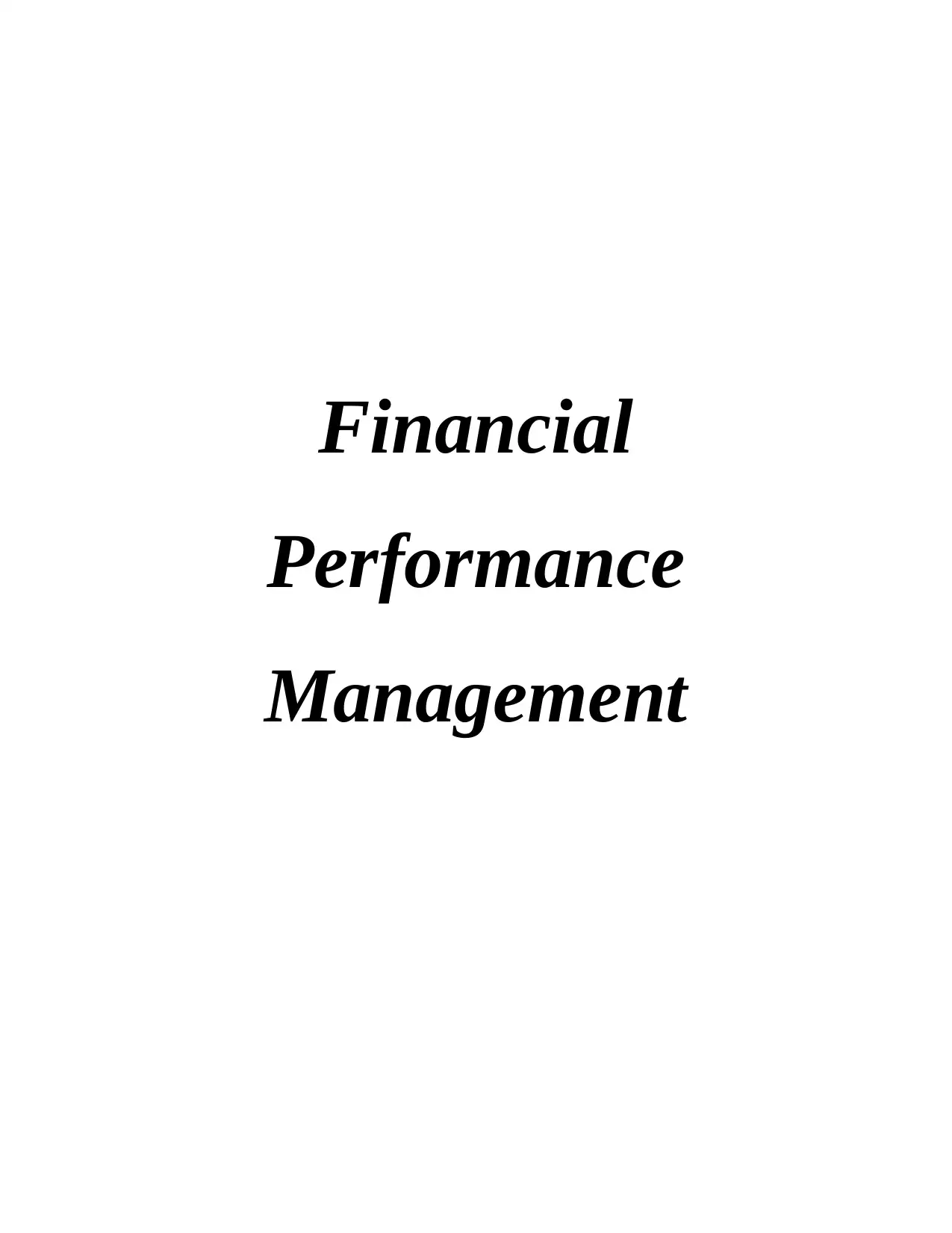
Financial
Performance
Management
Performance
Management
Paraphrase This Document
Need a fresh take? Get an instant paraphrase of this document with our AI Paraphraser
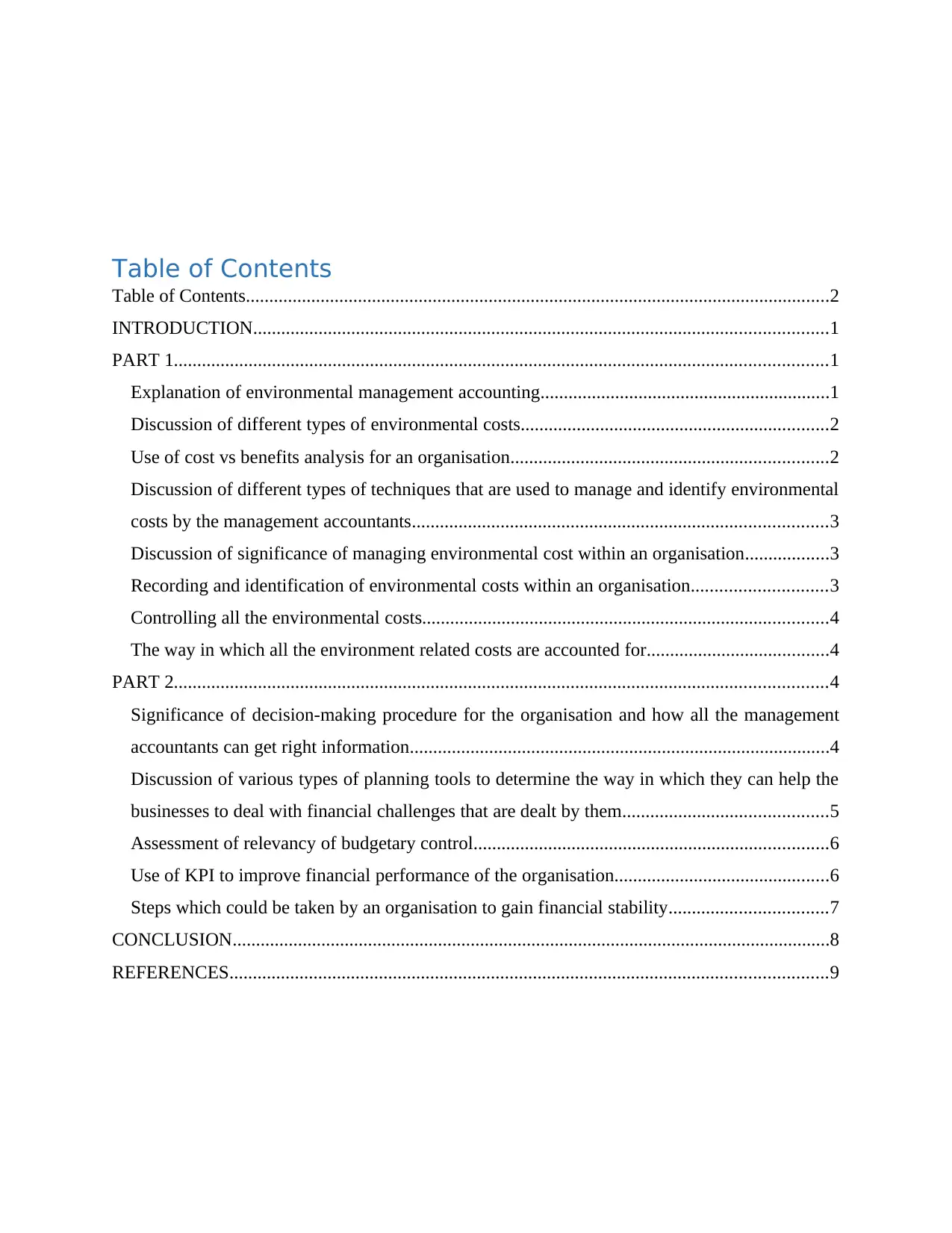
Table of Contents
Table of Contents.............................................................................................................................2
INTRODUCTION...........................................................................................................................1
PART 1............................................................................................................................................1
Explanation of environmental management accounting..............................................................1
Discussion of different types of environmental costs..................................................................2
Use of cost vs benefits analysis for an organisation....................................................................2
Discussion of different types of techniques that are used to manage and identify environmental
costs by the management accountants.........................................................................................3
Discussion of significance of managing environmental cost within an organisation..................3
Recording and identification of environmental costs within an organisation.............................3
Controlling all the environmental costs.......................................................................................4
The way in which all the environment related costs are accounted for.......................................4
PART 2............................................................................................................................................4
Significance of decision-making procedure for the organisation and how all the management
accountants can get right information..........................................................................................4
Discussion of various types of planning tools to determine the way in which they can help the
businesses to deal with financial challenges that are dealt by them............................................5
Assessment of relevancy of budgetary control............................................................................6
Use of KPI to improve financial performance of the organisation..............................................6
Steps which could be taken by an organisation to gain financial stability..................................7
CONCLUSION................................................................................................................................8
REFERENCES................................................................................................................................9
Table of Contents.............................................................................................................................2
INTRODUCTION...........................................................................................................................1
PART 1............................................................................................................................................1
Explanation of environmental management accounting..............................................................1
Discussion of different types of environmental costs..................................................................2
Use of cost vs benefits analysis for an organisation....................................................................2
Discussion of different types of techniques that are used to manage and identify environmental
costs by the management accountants.........................................................................................3
Discussion of significance of managing environmental cost within an organisation..................3
Recording and identification of environmental costs within an organisation.............................3
Controlling all the environmental costs.......................................................................................4
The way in which all the environment related costs are accounted for.......................................4
PART 2............................................................................................................................................4
Significance of decision-making procedure for the organisation and how all the management
accountants can get right information..........................................................................................4
Discussion of various types of planning tools to determine the way in which they can help the
businesses to deal with financial challenges that are dealt by them............................................5
Assessment of relevancy of budgetary control............................................................................6
Use of KPI to improve financial performance of the organisation..............................................6
Steps which could be taken by an organisation to gain financial stability..................................7
CONCLUSION................................................................................................................................8
REFERENCES................................................................................................................................9
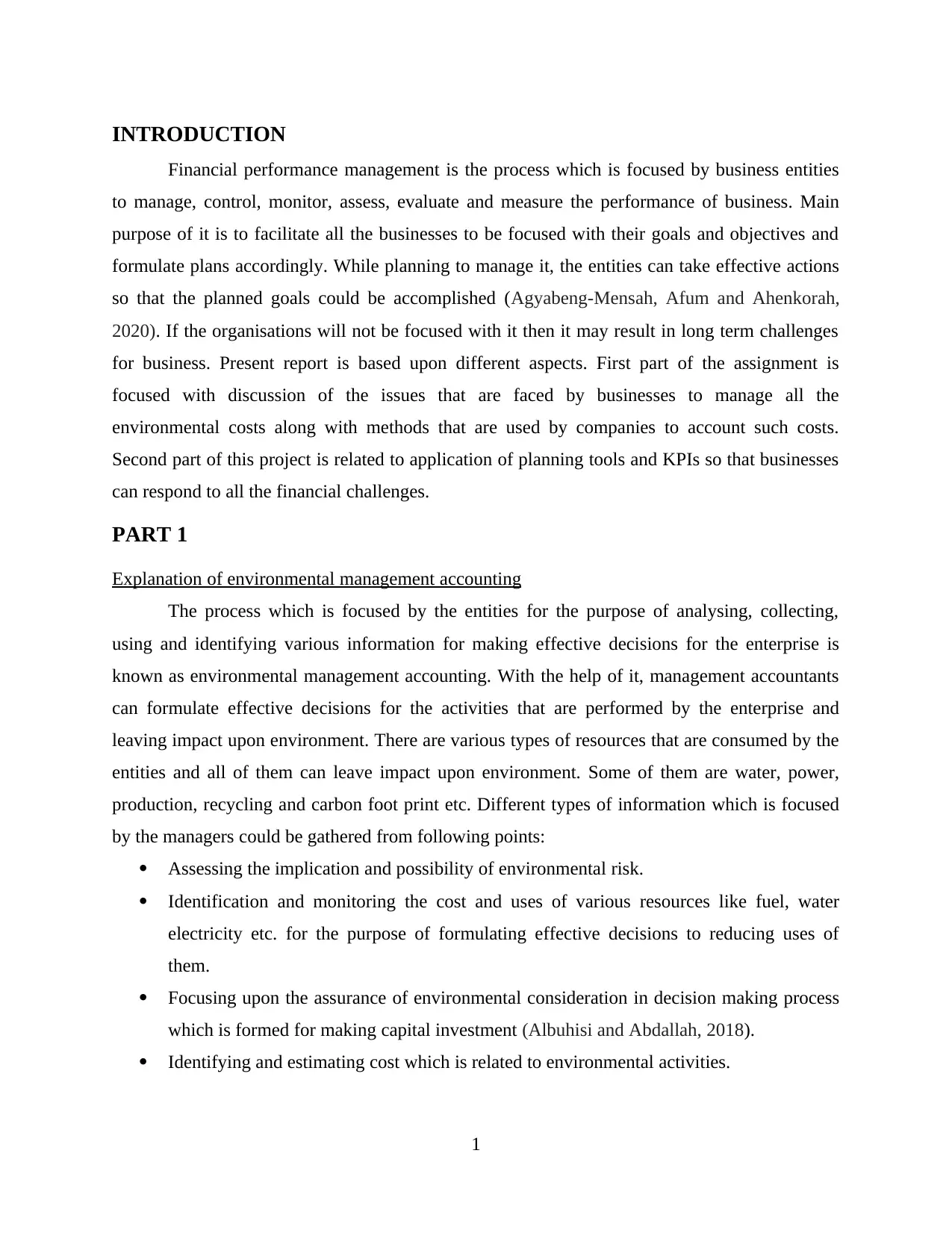
INTRODUCTION
Financial performance management is the process which is focused by business entities
to manage, control, monitor, assess, evaluate and measure the performance of business. Main
purpose of it is to facilitate all the businesses to be focused with their goals and objectives and
formulate plans accordingly. While planning to manage it, the entities can take effective actions
so that the planned goals could be accomplished (Agyabeng-Mensah, Afum and Ahenkorah,
2020). If the organisations will not be focused with it then it may result in long term challenges
for business. Present report is based upon different aspects. First part of the assignment is
focused with discussion of the issues that are faced by businesses to manage all the
environmental costs along with methods that are used by companies to account such costs.
Second part of this project is related to application of planning tools and KPIs so that businesses
can respond to all the financial challenges.
PART 1
Explanation of environmental management accounting
The process which is focused by the entities for the purpose of analysing, collecting,
using and identifying various information for making effective decisions for the enterprise is
known as environmental management accounting. With the help of it, management accountants
can formulate effective decisions for the activities that are performed by the enterprise and
leaving impact upon environment. There are various types of resources that are consumed by the
entities and all of them can leave impact upon environment. Some of them are water, power,
production, recycling and carbon foot print etc. Different types of information which is focused
by the managers could be gathered from following points:
Assessing the implication and possibility of environmental risk.
Identification and monitoring the cost and uses of various resources like fuel, water
electricity etc. for the purpose of formulating effective decisions to reducing uses of
them.
Focusing upon the assurance of environmental consideration in decision making process
which is formed for making capital investment (Albuhisi and Abdallah, 2018).
Identifying and estimating cost which is related to environmental activities.
1
Financial performance management is the process which is focused by business entities
to manage, control, monitor, assess, evaluate and measure the performance of business. Main
purpose of it is to facilitate all the businesses to be focused with their goals and objectives and
formulate plans accordingly. While planning to manage it, the entities can take effective actions
so that the planned goals could be accomplished (Agyabeng-Mensah, Afum and Ahenkorah,
2020). If the organisations will not be focused with it then it may result in long term challenges
for business. Present report is based upon different aspects. First part of the assignment is
focused with discussion of the issues that are faced by businesses to manage all the
environmental costs along with methods that are used by companies to account such costs.
Second part of this project is related to application of planning tools and KPIs so that businesses
can respond to all the financial challenges.
PART 1
Explanation of environmental management accounting
The process which is focused by the entities for the purpose of analysing, collecting,
using and identifying various information for making effective decisions for the enterprise is
known as environmental management accounting. With the help of it, management accountants
can formulate effective decisions for the activities that are performed by the enterprise and
leaving impact upon environment. There are various types of resources that are consumed by the
entities and all of them can leave impact upon environment. Some of them are water, power,
production, recycling and carbon foot print etc. Different types of information which is focused
by the managers could be gathered from following points:
Assessing the implication and possibility of environmental risk.
Identification and monitoring the cost and uses of various resources like fuel, water
electricity etc. for the purpose of formulating effective decisions to reducing uses of
them.
Focusing upon the assurance of environmental consideration in decision making process
which is formed for making capital investment (Albuhisi and Abdallah, 2018).
Identifying and estimating cost which is related to environmental activities.
1
⊘ This is a preview!⊘
Do you want full access?
Subscribe today to unlock all pages.

Trusted by 1+ million students worldwide
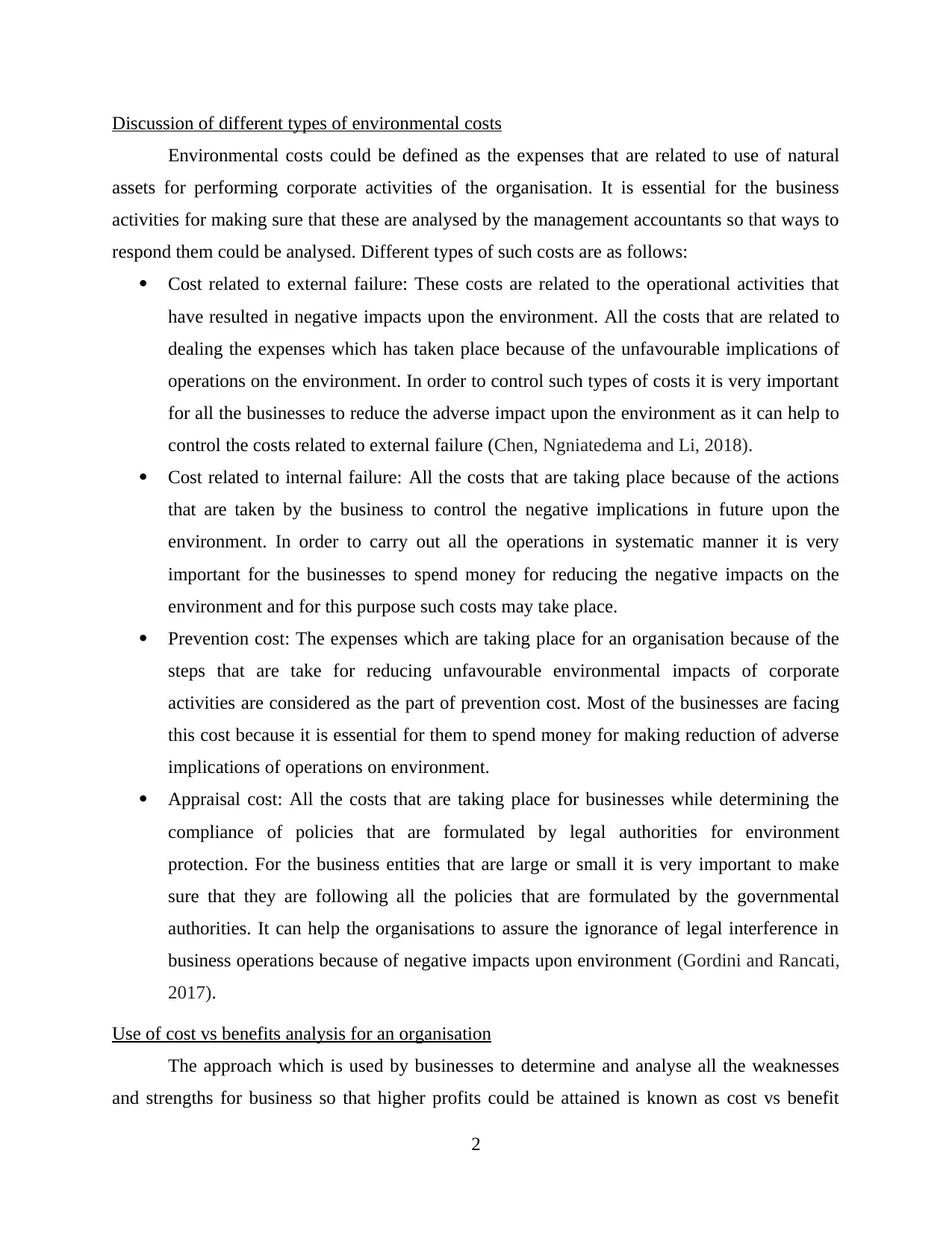
Discussion of different types of environmental costs
Environmental costs could be defined as the expenses that are related to use of natural
assets for performing corporate activities of the organisation. It is essential for the business
activities for making sure that these are analysed by the management accountants so that ways to
respond them could be analysed. Different types of such costs are as follows:
Cost related to external failure: These costs are related to the operational activities that
have resulted in negative impacts upon the environment. All the costs that are related to
dealing the expenses which has taken place because of the unfavourable implications of
operations on the environment. In order to control such types of costs it is very important
for all the businesses to reduce the adverse impact upon the environment as it can help to
control the costs related to external failure (Chen, Ngniatedema and Li, 2018).
Cost related to internal failure: All the costs that are taking place because of the actions
that are taken by the business to control the negative implications in future upon the
environment. In order to carry out all the operations in systematic manner it is very
important for the businesses to spend money for reducing the negative impacts on the
environment and for this purpose such costs may take place.
Prevention cost: The expenses which are taking place for an organisation because of the
steps that are take for reducing unfavourable environmental impacts of corporate
activities are considered as the part of prevention cost. Most of the businesses are facing
this cost because it is essential for them to spend money for making reduction of adverse
implications of operations on environment.
Appraisal cost: All the costs that are taking place for businesses while determining the
compliance of policies that are formulated by legal authorities for environment
protection. For the business entities that are large or small it is very important to make
sure that they are following all the policies that are formulated by the governmental
authorities. It can help the organisations to assure the ignorance of legal interference in
business operations because of negative impacts upon environment (Gordini and Rancati,
2017).
Use of cost vs benefits analysis for an organisation
The approach which is used by businesses to determine and analyse all the weaknesses
and strengths for business so that higher profits could be attained is known as cost vs benefit
2
Environmental costs could be defined as the expenses that are related to use of natural
assets for performing corporate activities of the organisation. It is essential for the business
activities for making sure that these are analysed by the management accountants so that ways to
respond them could be analysed. Different types of such costs are as follows:
Cost related to external failure: These costs are related to the operational activities that
have resulted in negative impacts upon the environment. All the costs that are related to
dealing the expenses which has taken place because of the unfavourable implications of
operations on the environment. In order to control such types of costs it is very important
for all the businesses to reduce the adverse impact upon the environment as it can help to
control the costs related to external failure (Chen, Ngniatedema and Li, 2018).
Cost related to internal failure: All the costs that are taking place because of the actions
that are taken by the business to control the negative implications in future upon the
environment. In order to carry out all the operations in systematic manner it is very
important for the businesses to spend money for reducing the negative impacts on the
environment and for this purpose such costs may take place.
Prevention cost: The expenses which are taking place for an organisation because of the
steps that are take for reducing unfavourable environmental impacts of corporate
activities are considered as the part of prevention cost. Most of the businesses are facing
this cost because it is essential for them to spend money for making reduction of adverse
implications of operations on environment.
Appraisal cost: All the costs that are taking place for businesses while determining the
compliance of policies that are formulated by legal authorities for environment
protection. For the business entities that are large or small it is very important to make
sure that they are following all the policies that are formulated by the governmental
authorities. It can help the organisations to assure the ignorance of legal interference in
business operations because of negative impacts upon environment (Gordini and Rancati,
2017).
Use of cost vs benefits analysis for an organisation
The approach which is used by businesses to determine and analyse all the weaknesses
and strengths for business so that higher profits could be attained is known as cost vs benefit
2
Paraphrase This Document
Need a fresh take? Get an instant paraphrase of this document with our AI Paraphraser
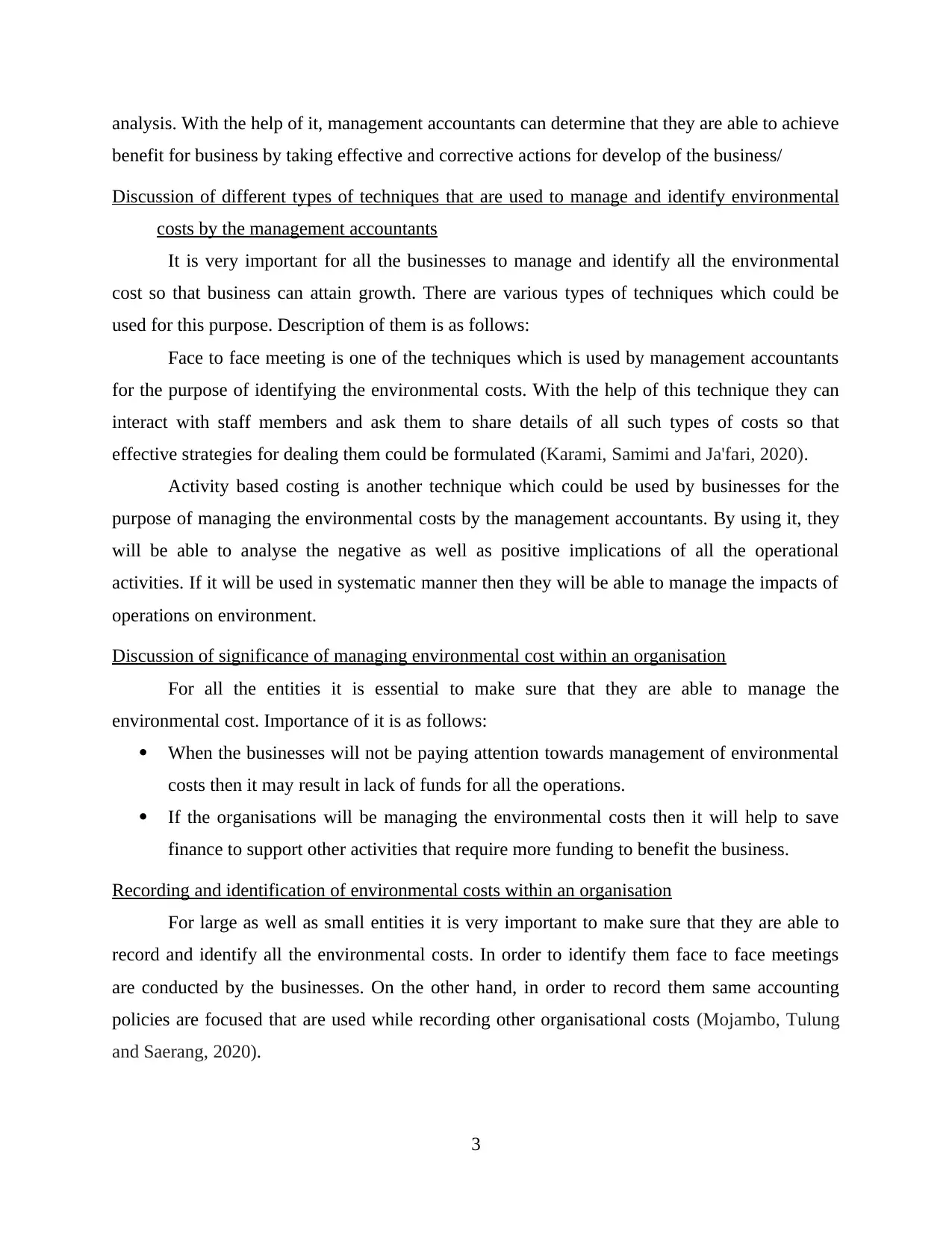
analysis. With the help of it, management accountants can determine that they are able to achieve
benefit for business by taking effective and corrective actions for develop of the business/
Discussion of different types of techniques that are used to manage and identify environmental
costs by the management accountants
It is very important for all the businesses to manage and identify all the environmental
cost so that business can attain growth. There are various types of techniques which could be
used for this purpose. Description of them is as follows:
Face to face meeting is one of the techniques which is used by management accountants
for the purpose of identifying the environmental costs. With the help of this technique they can
interact with staff members and ask them to share details of all such types of costs so that
effective strategies for dealing them could be formulated (Karami, Samimi and Ja'fari, 2020).
Activity based costing is another technique which could be used by businesses for the
purpose of managing the environmental costs by the management accountants. By using it, they
will be able to analyse the negative as well as positive implications of all the operational
activities. If it will be used in systematic manner then they will be able to manage the impacts of
operations on environment.
Discussion of significance of managing environmental cost within an organisation
For all the entities it is essential to make sure that they are able to manage the
environmental cost. Importance of it is as follows:
When the businesses will not be paying attention towards management of environmental
costs then it may result in lack of funds for all the operations.
If the organisations will be managing the environmental costs then it will help to save
finance to support other activities that require more funding to benefit the business.
Recording and identification of environmental costs within an organisation
For large as well as small entities it is very important to make sure that they are able to
record and identify all the environmental costs. In order to identify them face to face meetings
are conducted by the businesses. On the other hand, in order to record them same accounting
policies are focused that are used while recording other organisational costs (Mojambo, Tulung
and Saerang, 2020).
3
benefit for business by taking effective and corrective actions for develop of the business/
Discussion of different types of techniques that are used to manage and identify environmental
costs by the management accountants
It is very important for all the businesses to manage and identify all the environmental
cost so that business can attain growth. There are various types of techniques which could be
used for this purpose. Description of them is as follows:
Face to face meeting is one of the techniques which is used by management accountants
for the purpose of identifying the environmental costs. With the help of this technique they can
interact with staff members and ask them to share details of all such types of costs so that
effective strategies for dealing them could be formulated (Karami, Samimi and Ja'fari, 2020).
Activity based costing is another technique which could be used by businesses for the
purpose of managing the environmental costs by the management accountants. By using it, they
will be able to analyse the negative as well as positive implications of all the operational
activities. If it will be used in systematic manner then they will be able to manage the impacts of
operations on environment.
Discussion of significance of managing environmental cost within an organisation
For all the entities it is essential to make sure that they are able to manage the
environmental cost. Importance of it is as follows:
When the businesses will not be paying attention towards management of environmental
costs then it may result in lack of funds for all the operations.
If the organisations will be managing the environmental costs then it will help to save
finance to support other activities that require more funding to benefit the business.
Recording and identification of environmental costs within an organisation
For large as well as small entities it is very important to make sure that they are able to
record and identify all the environmental costs. In order to identify them face to face meetings
are conducted by the businesses. On the other hand, in order to record them same accounting
policies are focused that are used while recording other organisational costs (Mojambo, Tulung
and Saerang, 2020).
3
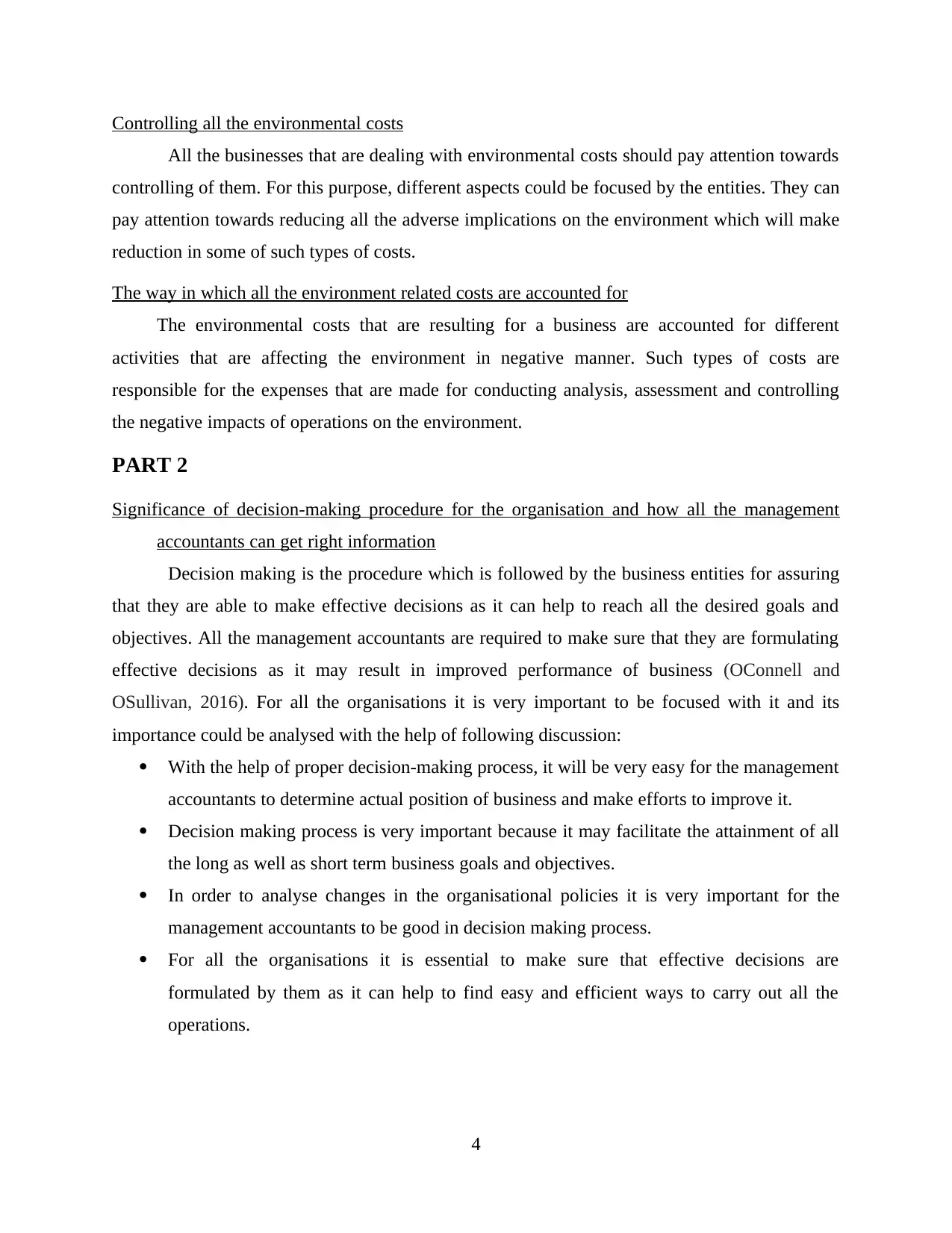
Controlling all the environmental costs
All the businesses that are dealing with environmental costs should pay attention towards
controlling of them. For this purpose, different aspects could be focused by the entities. They can
pay attention towards reducing all the adverse implications on the environment which will make
reduction in some of such types of costs.
The way in which all the environment related costs are accounted for
The environmental costs that are resulting for a business are accounted for different
activities that are affecting the environment in negative manner. Such types of costs are
responsible for the expenses that are made for conducting analysis, assessment and controlling
the negative impacts of operations on the environment.
PART 2
Significance of decision-making procedure for the organisation and how all the management
accountants can get right information
Decision making is the procedure which is followed by the business entities for assuring
that they are able to make effective decisions as it can help to reach all the desired goals and
objectives. All the management accountants are required to make sure that they are formulating
effective decisions as it may result in improved performance of business (OConnell and
OSullivan, 2016). For all the organisations it is very important to be focused with it and its
importance could be analysed with the help of following discussion:
With the help of proper decision-making process, it will be very easy for the management
accountants to determine actual position of business and make efforts to improve it.
Decision making process is very important because it may facilitate the attainment of all
the long as well as short term business goals and objectives.
In order to analyse changes in the organisational policies it is very important for the
management accountants to be good in decision making process.
For all the organisations it is essential to make sure that effective decisions are
formulated by them as it can help to find easy and efficient ways to carry out all the
operations.
4
All the businesses that are dealing with environmental costs should pay attention towards
controlling of them. For this purpose, different aspects could be focused by the entities. They can
pay attention towards reducing all the adverse implications on the environment which will make
reduction in some of such types of costs.
The way in which all the environment related costs are accounted for
The environmental costs that are resulting for a business are accounted for different
activities that are affecting the environment in negative manner. Such types of costs are
responsible for the expenses that are made for conducting analysis, assessment and controlling
the negative impacts of operations on the environment.
PART 2
Significance of decision-making procedure for the organisation and how all the management
accountants can get right information
Decision making is the procedure which is followed by the business entities for assuring
that they are able to make effective decisions as it can help to reach all the desired goals and
objectives. All the management accountants are required to make sure that they are formulating
effective decisions as it may result in improved performance of business (OConnell and
OSullivan, 2016). For all the organisations it is very important to be focused with it and its
importance could be analysed with the help of following discussion:
With the help of proper decision-making process, it will be very easy for the management
accountants to determine actual position of business and make efforts to improve it.
Decision making process is very important because it may facilitate the attainment of all
the long as well as short term business goals and objectives.
In order to analyse changes in the organisational policies it is very important for the
management accountants to be good in decision making process.
For all the organisations it is essential to make sure that effective decisions are
formulated by them as it can help to find easy and efficient ways to carry out all the
operations.
4
⊘ This is a preview!⊘
Do you want full access?
Subscribe today to unlock all pages.

Trusted by 1+ million students worldwide
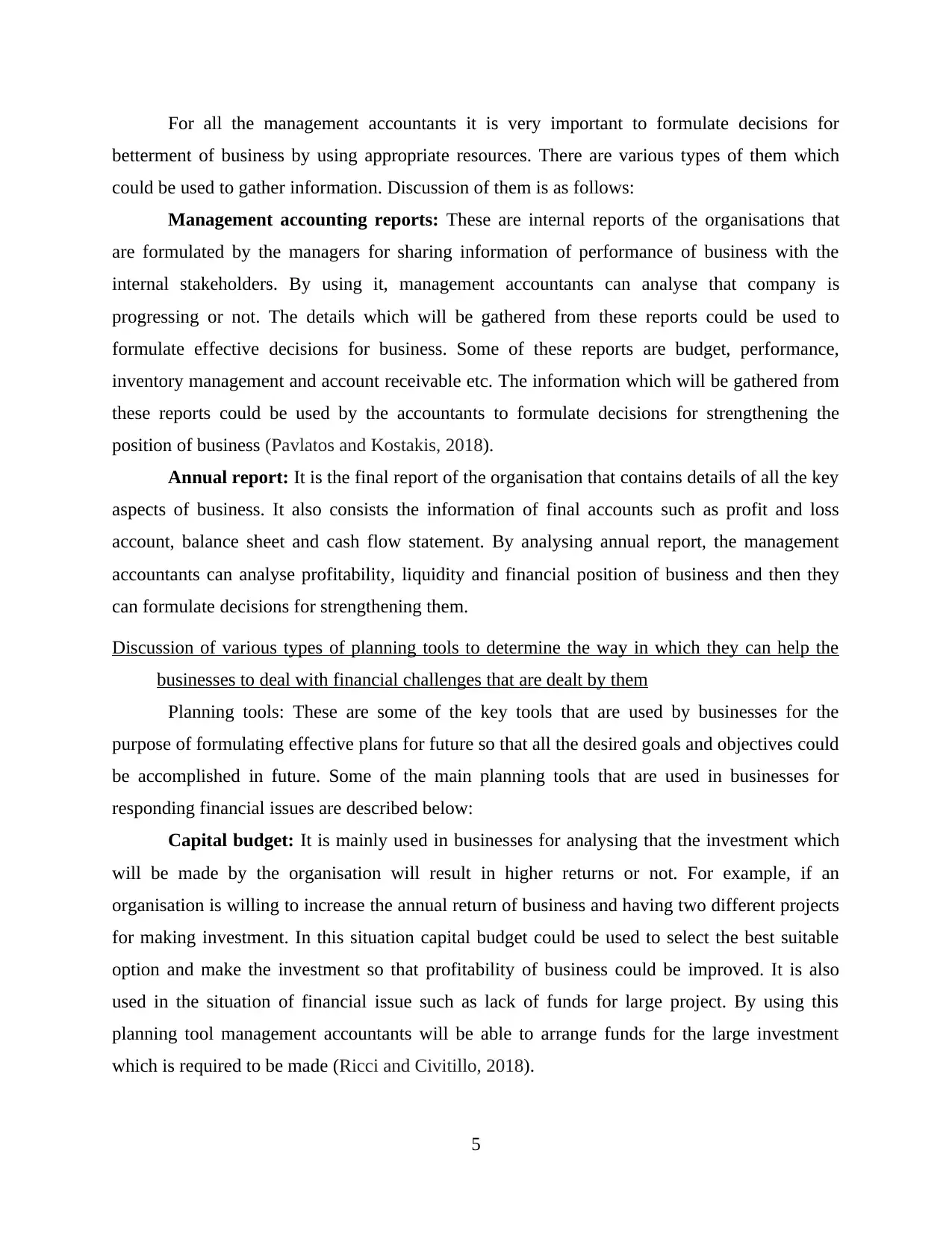
For all the management accountants it is very important to formulate decisions for
betterment of business by using appropriate resources. There are various types of them which
could be used to gather information. Discussion of them is as follows:
Management accounting reports: These are internal reports of the organisations that
are formulated by the managers for sharing information of performance of business with the
internal stakeholders. By using it, management accountants can analyse that company is
progressing or not. The details which will be gathered from these reports could be used to
formulate effective decisions for business. Some of these reports are budget, performance,
inventory management and account receivable etc. The information which will be gathered from
these reports could be used by the accountants to formulate decisions for strengthening the
position of business (Pavlatos and Kostakis, 2018).
Annual report: It is the final report of the organisation that contains details of all the key
aspects of business. It also consists the information of final accounts such as profit and loss
account, balance sheet and cash flow statement. By analysing annual report, the management
accountants can analyse profitability, liquidity and financial position of business and then they
can formulate decisions for strengthening them.
Discussion of various types of planning tools to determine the way in which they can help the
businesses to deal with financial challenges that are dealt by them
Planning tools: These are some of the key tools that are used by businesses for the
purpose of formulating effective plans for future so that all the desired goals and objectives could
be accomplished in future. Some of the main planning tools that are used in businesses for
responding financial issues are described below:
Capital budget: It is mainly used in businesses for analysing that the investment which
will be made by the organisation will result in higher returns or not. For example, if an
organisation is willing to increase the annual return of business and having two different projects
for making investment. In this situation capital budget could be used to select the best suitable
option and make the investment so that profitability of business could be improved. It is also
used in the situation of financial issue such as lack of funds for large project. By using this
planning tool management accountants will be able to arrange funds for the large investment
which is required to be made (Ricci and Civitillo, 2018).
5
betterment of business by using appropriate resources. There are various types of them which
could be used to gather information. Discussion of them is as follows:
Management accounting reports: These are internal reports of the organisations that
are formulated by the managers for sharing information of performance of business with the
internal stakeholders. By using it, management accountants can analyse that company is
progressing or not. The details which will be gathered from these reports could be used to
formulate effective decisions for business. Some of these reports are budget, performance,
inventory management and account receivable etc. The information which will be gathered from
these reports could be used by the accountants to formulate decisions for strengthening the
position of business (Pavlatos and Kostakis, 2018).
Annual report: It is the final report of the organisation that contains details of all the key
aspects of business. It also consists the information of final accounts such as profit and loss
account, balance sheet and cash flow statement. By analysing annual report, the management
accountants can analyse profitability, liquidity and financial position of business and then they
can formulate decisions for strengthening them.
Discussion of various types of planning tools to determine the way in which they can help the
businesses to deal with financial challenges that are dealt by them
Planning tools: These are some of the key tools that are used by businesses for the
purpose of formulating effective plans for future so that all the desired goals and objectives could
be accomplished in future. Some of the main planning tools that are used in businesses for
responding financial issues are described below:
Capital budget: It is mainly used in businesses for analysing that the investment which
will be made by the organisation will result in higher returns or not. For example, if an
organisation is willing to increase the annual return of business and having two different projects
for making investment. In this situation capital budget could be used to select the best suitable
option and make the investment so that profitability of business could be improved. It is also
used in the situation of financial issue such as lack of funds for large project. By using this
planning tool management accountants will be able to arrange funds for the large investment
which is required to be made (Ricci and Civitillo, 2018).
5
Paraphrase This Document
Need a fresh take? Get an instant paraphrase of this document with our AI Paraphraser
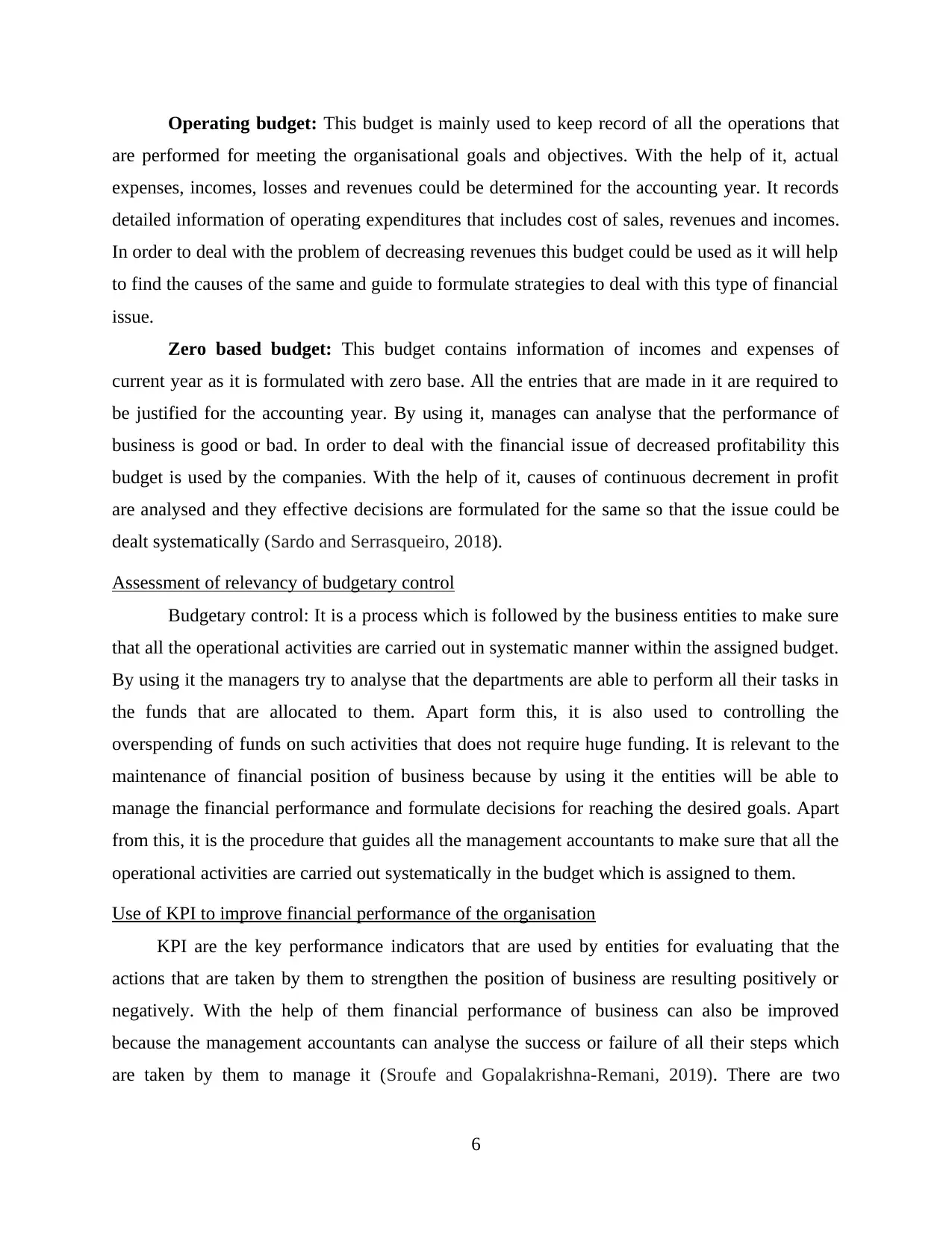
Operating budget: This budget is mainly used to keep record of all the operations that
are performed for meeting the organisational goals and objectives. With the help of it, actual
expenses, incomes, losses and revenues could be determined for the accounting year. It records
detailed information of operating expenditures that includes cost of sales, revenues and incomes.
In order to deal with the problem of decreasing revenues this budget could be used as it will help
to find the causes of the same and guide to formulate strategies to deal with this type of financial
issue.
Zero based budget: This budget contains information of incomes and expenses of
current year as it is formulated with zero base. All the entries that are made in it are required to
be justified for the accounting year. By using it, manages can analyse that the performance of
business is good or bad. In order to deal with the financial issue of decreased profitability this
budget is used by the companies. With the help of it, causes of continuous decrement in profit
are analysed and they effective decisions are formulated for the same so that the issue could be
dealt systematically (Sardo and Serrasqueiro, 2018).
Assessment of relevancy of budgetary control
Budgetary control: It is a process which is followed by the business entities to make sure
that all the operational activities are carried out in systematic manner within the assigned budget.
By using it the managers try to analyse that the departments are able to perform all their tasks in
the funds that are allocated to them. Apart form this, it is also used to controlling the
overspending of funds on such activities that does not require huge funding. It is relevant to the
maintenance of financial position of business because by using it the entities will be able to
manage the financial performance and formulate decisions for reaching the desired goals. Apart
from this, it is the procedure that guides all the management accountants to make sure that all the
operational activities are carried out systematically in the budget which is assigned to them.
Use of KPI to improve financial performance of the organisation
KPI are the key performance indicators that are used by entities for evaluating that the
actions that are taken by them to strengthen the position of business are resulting positively or
negatively. With the help of them financial performance of business can also be improved
because the management accountants can analyse the success or failure of all their steps which
are taken by them to manage it (Sroufe and Gopalakrishna-Remani, 2019). There are two
6
are performed for meeting the organisational goals and objectives. With the help of it, actual
expenses, incomes, losses and revenues could be determined for the accounting year. It records
detailed information of operating expenditures that includes cost of sales, revenues and incomes.
In order to deal with the problem of decreasing revenues this budget could be used as it will help
to find the causes of the same and guide to formulate strategies to deal with this type of financial
issue.
Zero based budget: This budget contains information of incomes and expenses of
current year as it is formulated with zero base. All the entries that are made in it are required to
be justified for the accounting year. By using it, manages can analyse that the performance of
business is good or bad. In order to deal with the financial issue of decreased profitability this
budget is used by the companies. With the help of it, causes of continuous decrement in profit
are analysed and they effective decisions are formulated for the same so that the issue could be
dealt systematically (Sardo and Serrasqueiro, 2018).
Assessment of relevancy of budgetary control
Budgetary control: It is a process which is followed by the business entities to make sure
that all the operational activities are carried out in systematic manner within the assigned budget.
By using it the managers try to analyse that the departments are able to perform all their tasks in
the funds that are allocated to them. Apart form this, it is also used to controlling the
overspending of funds on such activities that does not require huge funding. It is relevant to the
maintenance of financial position of business because by using it the entities will be able to
manage the financial performance and formulate decisions for reaching the desired goals. Apart
from this, it is the procedure that guides all the management accountants to make sure that all the
operational activities are carried out systematically in the budget which is assigned to them.
Use of KPI to improve financial performance of the organisation
KPI are the key performance indicators that are used by entities for evaluating that the
actions that are taken by them to strengthen the position of business are resulting positively or
negatively. With the help of them financial performance of business can also be improved
because the management accountants can analyse the success or failure of all their steps which
are taken by them to manage it (Sroufe and Gopalakrishna-Remani, 2019). There are two
6
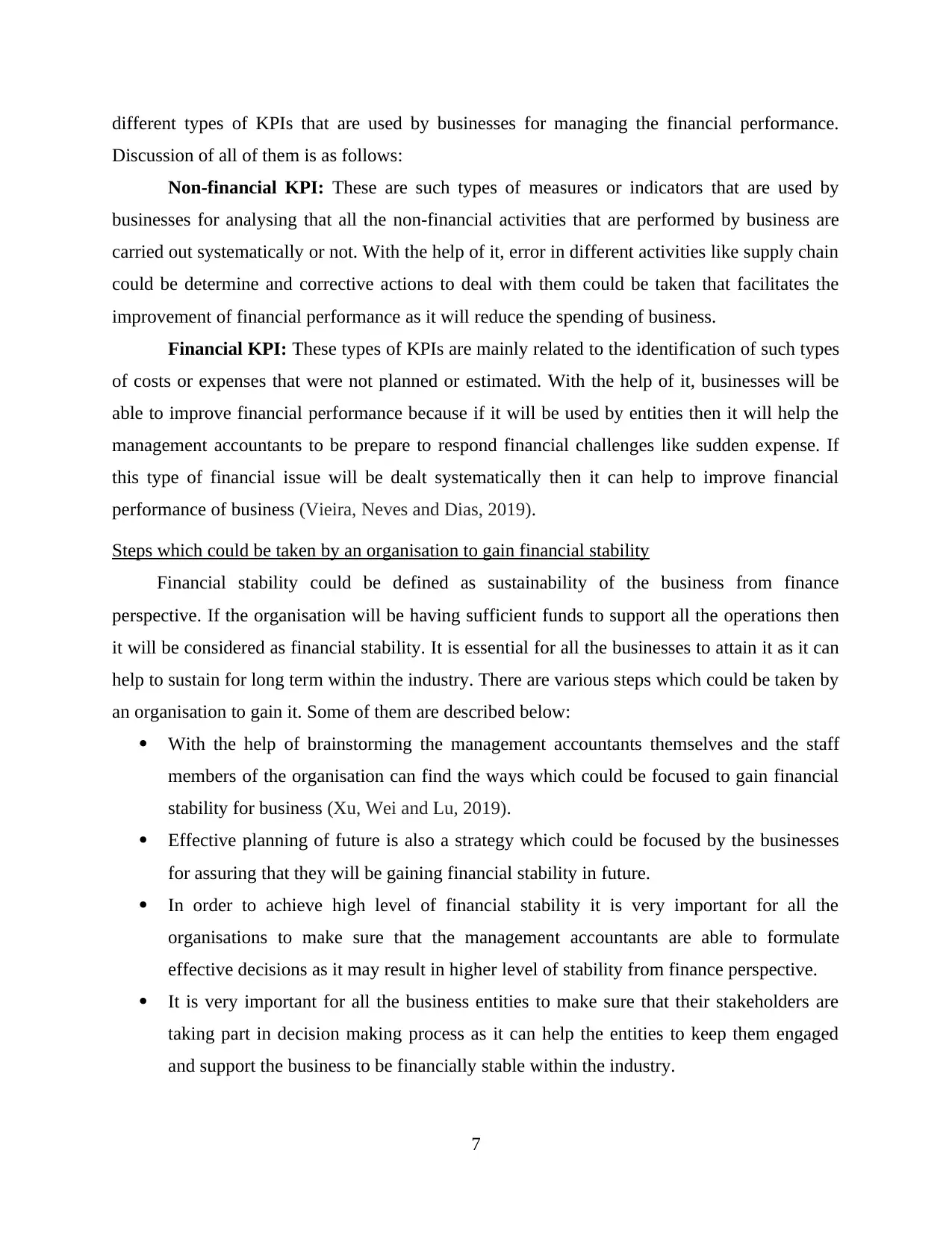
different types of KPIs that are used by businesses for managing the financial performance.
Discussion of all of them is as follows:
Non-financial KPI: These are such types of measures or indicators that are used by
businesses for analysing that all the non-financial activities that are performed by business are
carried out systematically or not. With the help of it, error in different activities like supply chain
could be determine and corrective actions to deal with them could be taken that facilitates the
improvement of financial performance as it will reduce the spending of business.
Financial KPI: These types of KPIs are mainly related to the identification of such types
of costs or expenses that were not planned or estimated. With the help of it, businesses will be
able to improve financial performance because if it will be used by entities then it will help the
management accountants to be prepare to respond financial challenges like sudden expense. If
this type of financial issue will be dealt systematically then it can help to improve financial
performance of business (Vieira, Neves and Dias, 2019).
Steps which could be taken by an organisation to gain financial stability
Financial stability could be defined as sustainability of the business from finance
perspective. If the organisation will be having sufficient funds to support all the operations then
it will be considered as financial stability. It is essential for all the businesses to attain it as it can
help to sustain for long term within the industry. There are various steps which could be taken by
an organisation to gain it. Some of them are described below:
With the help of brainstorming the management accountants themselves and the staff
members of the organisation can find the ways which could be focused to gain financial
stability for business (Xu, Wei and Lu, 2019).
Effective planning of future is also a strategy which could be focused by the businesses
for assuring that they will be gaining financial stability in future.
In order to achieve high level of financial stability it is very important for all the
organisations to make sure that the management accountants are able to formulate
effective decisions as it may result in higher level of stability from finance perspective.
It is very important for all the business entities to make sure that their stakeholders are
taking part in decision making process as it can help the entities to keep them engaged
and support the business to be financially stable within the industry.
7
Discussion of all of them is as follows:
Non-financial KPI: These are such types of measures or indicators that are used by
businesses for analysing that all the non-financial activities that are performed by business are
carried out systematically or not. With the help of it, error in different activities like supply chain
could be determine and corrective actions to deal with them could be taken that facilitates the
improvement of financial performance as it will reduce the spending of business.
Financial KPI: These types of KPIs are mainly related to the identification of such types
of costs or expenses that were not planned or estimated. With the help of it, businesses will be
able to improve financial performance because if it will be used by entities then it will help the
management accountants to be prepare to respond financial challenges like sudden expense. If
this type of financial issue will be dealt systematically then it can help to improve financial
performance of business (Vieira, Neves and Dias, 2019).
Steps which could be taken by an organisation to gain financial stability
Financial stability could be defined as sustainability of the business from finance
perspective. If the organisation will be having sufficient funds to support all the operations then
it will be considered as financial stability. It is essential for all the businesses to attain it as it can
help to sustain for long term within the industry. There are various steps which could be taken by
an organisation to gain it. Some of them are described below:
With the help of brainstorming the management accountants themselves and the staff
members of the organisation can find the ways which could be focused to gain financial
stability for business (Xu, Wei and Lu, 2019).
Effective planning of future is also a strategy which could be focused by the businesses
for assuring that they will be gaining financial stability in future.
In order to achieve high level of financial stability it is very important for all the
organisations to make sure that the management accountants are able to formulate
effective decisions as it may result in higher level of stability from finance perspective.
It is very important for all the business entities to make sure that their stakeholders are
taking part in decision making process as it can help the entities to keep them engaged
and support the business to be financially stable within the industry.
7
⊘ This is a preview!⊘
Do you want full access?
Subscribe today to unlock all pages.

Trusted by 1+ million students worldwide
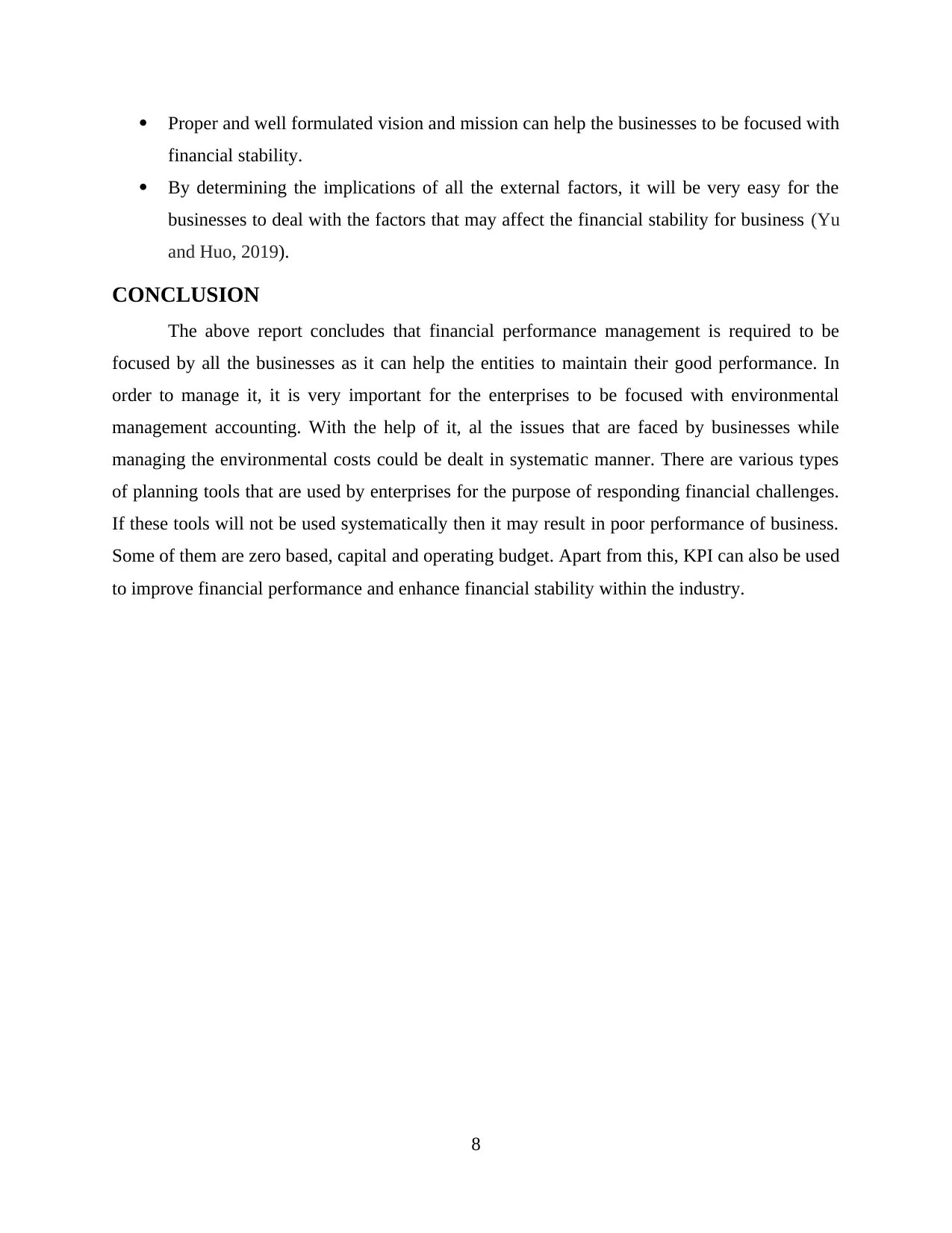
Proper and well formulated vision and mission can help the businesses to be focused with
financial stability.
By determining the implications of all the external factors, it will be very easy for the
businesses to deal with the factors that may affect the financial stability for business (Yu
and Huo, 2019).
CONCLUSION
The above report concludes that financial performance management is required to be
focused by all the businesses as it can help the entities to maintain their good performance. In
order to manage it, it is very important for the enterprises to be focused with environmental
management accounting. With the help of it, al the issues that are faced by businesses while
managing the environmental costs could be dealt in systematic manner. There are various types
of planning tools that are used by enterprises for the purpose of responding financial challenges.
If these tools will not be used systematically then it may result in poor performance of business.
Some of them are zero based, capital and operating budget. Apart from this, KPI can also be used
to improve financial performance and enhance financial stability within the industry.
8
financial stability.
By determining the implications of all the external factors, it will be very easy for the
businesses to deal with the factors that may affect the financial stability for business (Yu
and Huo, 2019).
CONCLUSION
The above report concludes that financial performance management is required to be
focused by all the businesses as it can help the entities to maintain their good performance. In
order to manage it, it is very important for the enterprises to be focused with environmental
management accounting. With the help of it, al the issues that are faced by businesses while
managing the environmental costs could be dealt in systematic manner. There are various types
of planning tools that are used by enterprises for the purpose of responding financial challenges.
If these tools will not be used systematically then it may result in poor performance of business.
Some of them are zero based, capital and operating budget. Apart from this, KPI can also be used
to improve financial performance and enhance financial stability within the industry.
8
Paraphrase This Document
Need a fresh take? Get an instant paraphrase of this document with our AI Paraphraser
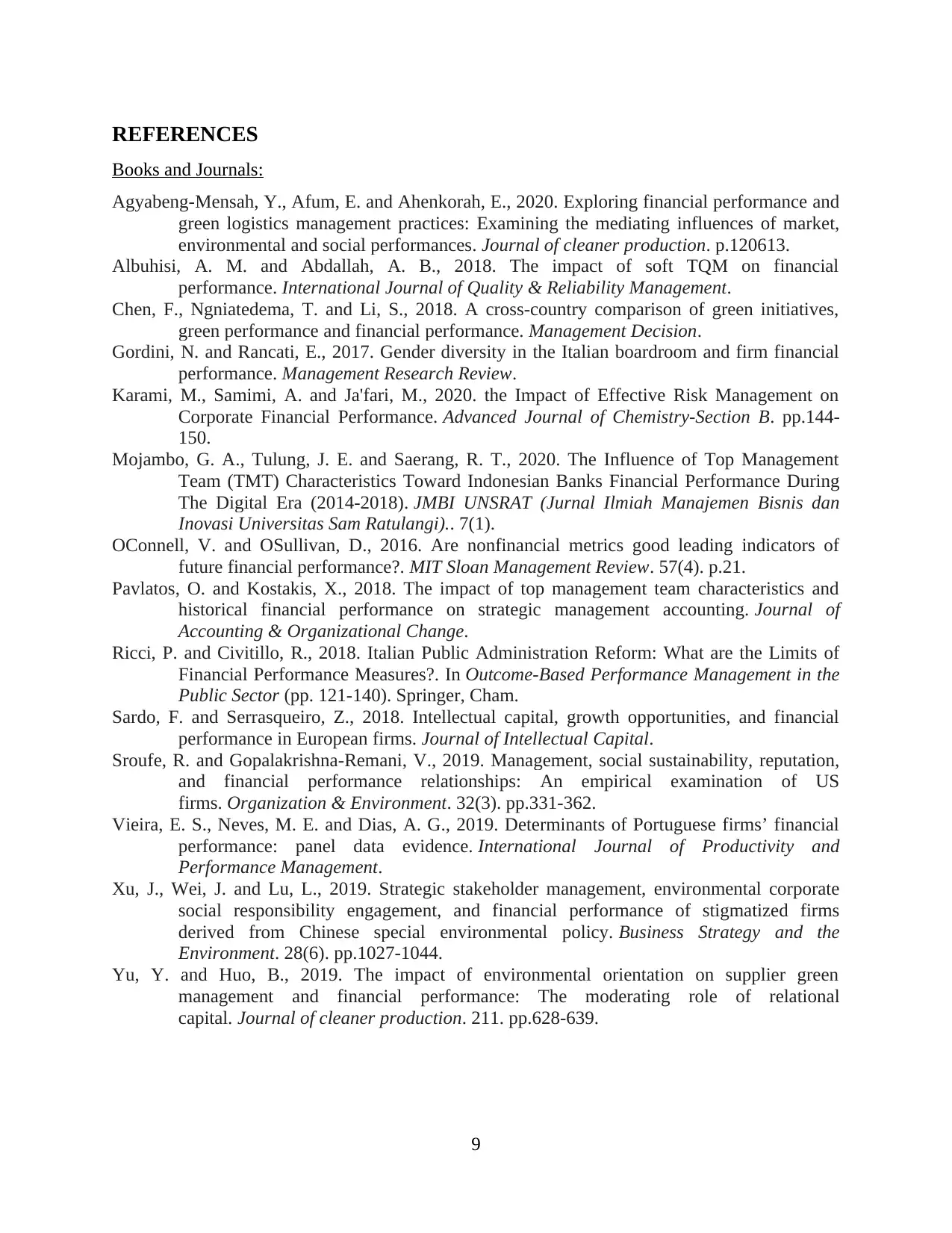
REFERENCES
Books and Journals:
Agyabeng-Mensah, Y., Afum, E. and Ahenkorah, E., 2020. Exploring financial performance and
green logistics management practices: Examining the mediating influences of market,
environmental and social performances. Journal of cleaner production. p.120613.
Albuhisi, A. M. and Abdallah, A. B., 2018. The impact of soft TQM on financial
performance. International Journal of Quality & Reliability Management.
Chen, F., Ngniatedema, T. and Li, S., 2018. A cross-country comparison of green initiatives,
green performance and financial performance. Management Decision.
Gordini, N. and Rancati, E., 2017. Gender diversity in the Italian boardroom and firm financial
performance. Management Research Review.
Karami, M., Samimi, A. and Ja'fari, M., 2020. the Impact of Effective Risk Management on
Corporate Financial Performance. Advanced Journal of Chemistry-Section B. pp.144-
150.
Mojambo, G. A., Tulung, J. E. and Saerang, R. T., 2020. The Influence of Top Management
Team (TMT) Characteristics Toward Indonesian Banks Financial Performance During
The Digital Era (2014-2018). JMBI UNSRAT (Jurnal Ilmiah Manajemen Bisnis dan
Inovasi Universitas Sam Ratulangi).. 7(1).
OConnell, V. and OSullivan, D., 2016. Are nonfinancial metrics good leading indicators of
future financial performance?. MIT Sloan Management Review. 57(4). p.21.
Pavlatos, O. and Kostakis, X., 2018. The impact of top management team characteristics and
historical financial performance on strategic management accounting. Journal of
Accounting & Organizational Change.
Ricci, P. and Civitillo, R., 2018. Italian Public Administration Reform: What are the Limits of
Financial Performance Measures?. In Outcome-Based Performance Management in the
Public Sector (pp. 121-140). Springer, Cham.
Sardo, F. and Serrasqueiro, Z., 2018. Intellectual capital, growth opportunities, and financial
performance in European firms. Journal of Intellectual Capital.
Sroufe, R. and Gopalakrishna-Remani, V., 2019. Management, social sustainability, reputation,
and financial performance relationships: An empirical examination of US
firms. Organization & Environment. 32(3). pp.331-362.
Vieira, E. S., Neves, M. E. and Dias, A. G., 2019. Determinants of Portuguese firms’ financial
performance: panel data evidence. International Journal of Productivity and
Performance Management.
Xu, J., Wei, J. and Lu, L., 2019. Strategic stakeholder management, environmental corporate
social responsibility engagement, and financial performance of stigmatized firms
derived from Chinese special environmental policy. Business Strategy and the
Environment. 28(6). pp.1027-1044.
Yu, Y. and Huo, B., 2019. The impact of environmental orientation on supplier green
management and financial performance: The moderating role of relational
capital. Journal of cleaner production. 211. pp.628-639.
9
Books and Journals:
Agyabeng-Mensah, Y., Afum, E. and Ahenkorah, E., 2020. Exploring financial performance and
green logistics management practices: Examining the mediating influences of market,
environmental and social performances. Journal of cleaner production. p.120613.
Albuhisi, A. M. and Abdallah, A. B., 2018. The impact of soft TQM on financial
performance. International Journal of Quality & Reliability Management.
Chen, F., Ngniatedema, T. and Li, S., 2018. A cross-country comparison of green initiatives,
green performance and financial performance. Management Decision.
Gordini, N. and Rancati, E., 2017. Gender diversity in the Italian boardroom and firm financial
performance. Management Research Review.
Karami, M., Samimi, A. and Ja'fari, M., 2020. the Impact of Effective Risk Management on
Corporate Financial Performance. Advanced Journal of Chemistry-Section B. pp.144-
150.
Mojambo, G. A., Tulung, J. E. and Saerang, R. T., 2020. The Influence of Top Management
Team (TMT) Characteristics Toward Indonesian Banks Financial Performance During
The Digital Era (2014-2018). JMBI UNSRAT (Jurnal Ilmiah Manajemen Bisnis dan
Inovasi Universitas Sam Ratulangi).. 7(1).
OConnell, V. and OSullivan, D., 2016. Are nonfinancial metrics good leading indicators of
future financial performance?. MIT Sloan Management Review. 57(4). p.21.
Pavlatos, O. and Kostakis, X., 2018. The impact of top management team characteristics and
historical financial performance on strategic management accounting. Journal of
Accounting & Organizational Change.
Ricci, P. and Civitillo, R., 2018. Italian Public Administration Reform: What are the Limits of
Financial Performance Measures?. In Outcome-Based Performance Management in the
Public Sector (pp. 121-140). Springer, Cham.
Sardo, F. and Serrasqueiro, Z., 2018. Intellectual capital, growth opportunities, and financial
performance in European firms. Journal of Intellectual Capital.
Sroufe, R. and Gopalakrishna-Remani, V., 2019. Management, social sustainability, reputation,
and financial performance relationships: An empirical examination of US
firms. Organization & Environment. 32(3). pp.331-362.
Vieira, E. S., Neves, M. E. and Dias, A. G., 2019. Determinants of Portuguese firms’ financial
performance: panel data evidence. International Journal of Productivity and
Performance Management.
Xu, J., Wei, J. and Lu, L., 2019. Strategic stakeholder management, environmental corporate
social responsibility engagement, and financial performance of stigmatized firms
derived from Chinese special environmental policy. Business Strategy and the
Environment. 28(6). pp.1027-1044.
Yu, Y. and Huo, B., 2019. The impact of environmental orientation on supplier green
management and financial performance: The moderating role of relational
capital. Journal of cleaner production. 211. pp.628-639.
9
1 out of 11
Related Documents
Your All-in-One AI-Powered Toolkit for Academic Success.
+13062052269
info@desklib.com
Available 24*7 on WhatsApp / Email
![[object Object]](/_next/static/media/star-bottom.7253800d.svg)
Unlock your academic potential
Copyright © 2020–2025 A2Z Services. All Rights Reserved. Developed and managed by ZUCOL.





